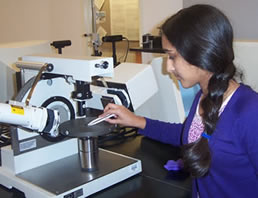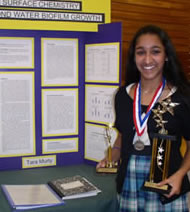|
Local Science Fair Winner Took Inquiry from Smith College Lab to Life
Amherst Regional Middle School student Tara Murty recently won the regional science fair for her research into biofilms – the subject of an ongoing inquiry at Smith College – qualifying her to compete at the State Science Fair in Worcester on June 5.
NORTHAMPTON, Mass. – Local eighth-grader Tara Murty recently took a college research question into the field and was rewarded with the top prize at the regional science fair.
At the same time, Murty’s research closely corresponded with what Smith College students had discovered in controlled experiments in the laboratory of Katherine Queeney, associate professor of chemistry.
 “This makes the case that our carefully controlled experiments in the lab are truly relevant to what happens in the natural environment,” said Queeney, adding “if I didn't believe our lab experiments had relevance to real systems, we wouldn't be doing them. But ‘relevance’ and ‘close correspondence’ are two very different things.” “This makes the case that our carefully controlled experiments in the lab are truly relevant to what happens in the natural environment,” said Queeney, adding “if I didn't believe our lab experiments had relevance to real systems, we wouldn't be doing them. But ‘relevance’ and ‘close correspondence’ are two very different things.”
Murty was introduced to Queeney by her Amherst Regional Middle School teacher, Jennifer Welborn.
For several years, Queeney’s Smith students have been working on modeling biofilms – bacterial mixtures that can cause harm to the surfaces they adhere to – to find out how the chemistry of those surfaces affect how the films grow. In their lab, molecules important to biofilm formation consistently grow in thicker layers on one type of surface (hydrophobic) than on another (hydrophilic).
Biofilms cause damage when they grow on everything from the inside of intravenous or catheter tubing in hospitals to the exterior of ships, said Murty. When biofilm grows on surfaces connected to humans, they cause infections. When biofilms grow on ships’ hulls, they add weight and friction to the vessel and accelerate the metal’s corrosion, costing the U.S. Navy millions of dollars a year.
Using hydrophilic and hydrophobic surfaces made in Queeney’s lab, Murty performed the research using water from Puffer’s Pond in Amherst, and analyzed her results using sophisticated equipment at Smith. She also performed some analysis at the University of Massachusetts, Amherst.
The middle-schooler’s biofilms not only followed the same general trend as has been documented in Queeney’s lab, but their thicknesses were on the same order of magnitude.
“The conclusion that hydrophilic substrates grow thinner biofilms suggests that a coating of hydrophilic material on ships’ hulls would lessen the biofilm growth,” Murty said. In recognition of the importance of her findings, Murty also won an award from the Office of Naval Research.

Beyond the excitement of winning the awards, Murty said, the research experience was meaningful because she felt treated like a college student while experimenting with highly technical equipment not available at middle or high schools.
However, Queeney noted, there was one big difference between the Murty and her students: “Tara had her poster done about two weeks in advance. You can ask my students if any of them have ever had a poster done before the absolute last minute – I know I never have!”
-30-
|























